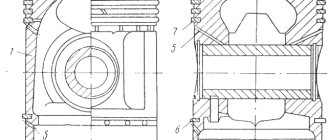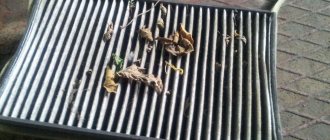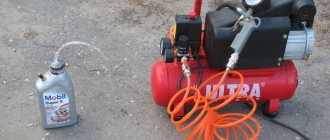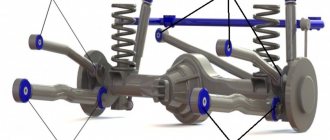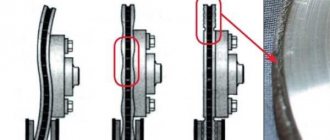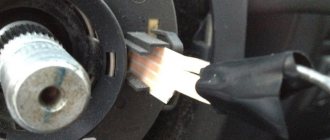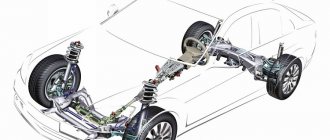Washing machines for parts. Cleaning engine parts until they shine
Today is an unusual article, despite its title, it is directly related to cars, or rather to parts. The thing is that now they use a lot of refurbished spare parts, but before they undergo processing in production, they need to be removed and, most importantly, washed well (to give them a marketable appearance)! But this is not always possible with your own hands, so special washing machines were created! Yes – yes, you heard right “big” machines that wash these spare parts. The article is informative, I think it will be useful to everyone...
What prompted me to write this was a washing machine I made with my own hands at a service station, or rather during disassembly. People who buy used cars remove normal spare parts and give them a marketable appearance by washing off a layer of dirt and oil from them. These can be gearboxes, engines, internal engine spare parts (pistons, shafts, valves, etc.), and discs can also be washed.
Advantages of homemade equipment
If there is no financial opportunity to purchase a device, or there is a desire to assemble high-pressure washing equipment with your own hands, the instructions given below will be of interest to you. Before you make a high-pressure washer, you should know about the advantages of the technology:
- low financial expenses;
- possibility of modernization;
- functionality at the level of production technology;
- fast production;
- operational simplicity;
- high efficiency;
- no need for spare parts and no additional expenses.
Using the equipment, it is possible to effectively, quickly and efficiently wash away contaminants of any degree of complexity. You can clean various surfaces of the car body. A homemade high-pressure washer, made and operated with your own hands, eliminates damage to the surfaces being treated. This quality favorably characterizes the cleansing technique in the eyes of the user.
Peculiarities
Ultrasonic baths are used in various fields. When washing cars, these devices are used mainly to clean engine parts, such as nozzles, injectors, filters and others, the washing of which by mechanical means is unacceptable or ineffective.
The peculiarity of the operation of an ultrasonic cleaner is that it carries out cleaning, eliminating the possibility of mechanical damage in the form of chips and scratches on the parts being cleaned.
At the same time, it effectively removes contaminants from places that are difficult to reach by mechanical cleaning and even copes with such types of contaminants as carbon deposits, corrosion, and industrial oils.
Operating principle
In appearance, a factory sink for parts is a square or rectangular container made of stainless steel. Ultrasonic transducers are attached to its walls from the inside. The source for them is an ultrasonic generator. Household models of the devices in question generally have a volume of about 1 liter, although there are sinks with a volume of up to 15 liters, and even larger options are used in industry.
The operating principle of the device in question is based on the fact that the parts washer creates ultrasonic vibrations with a frequency of 18 to 120 kHz. Ultrasonic vibrations are vibrations with a frequency exceeding 18 kHz. However, it is difficult to transmit them through air, so the parts washer contains liquid, which in this case serves as a medium for the propagation of ultrasonic waves.
When such vibrations pass through a liquid, a local decrease in pressure is formed, resulting in cavitation. This term refers to the formation of vapor and the subsequent condensation of air bubbles in the liquid flow, accompanied by hydraulic shocks and noise, that is, the appearance of cavities in the liquid filled with its vapor. Bubbles that move to an area characterized by higher pressure, or when the overall pressure increases, collapse, creating a shock wave. As a result, the mechanisms that function in conditions suitable for the manifestation of this process are destroyed.
However, parts washing is based on the controlled use of cavitation. Therefore, in this case, the described phenomenon does not destroy the objects placed in it, but removes various contaminants from them. Washing for parts allows you to change the frequency of the waves and the processing time, which makes it possible to select the optimal mode and the required degree of cleaning for the items being processed.
Is it possible to wash the cylinder head and other parts with your own hands?
The easiest way is to make your own high pressure washer.
Strong water pressure can remove dirt from a car, walls, doors, windows and other objects. But this cleaning method is not effective enough to be used for washing internal combustion engine parts. High-pressure washers use soap-based cleaning fluids, but they are not able to remove rust and technical fluid residues. Of course, you can try and make a sink for units from a barrel, which will imitate a professional machine. A homemade washing of engine parts will not be able to clean the components of the power unit as quickly and effectively. For high-quality cleaning, the liquid must be at a certain temperature. In addition, the consumption of washing liquid will be many times higher.
It is worth noting that specialized chemistry is very toxic to the human body. If the parts are not washed tightly enough, there is a possibility that harmful vapors will enter the human body when the liquid is heated.
The cost of professional equipment quickly pays for itself, so you shouldn’t skimp on it. By purchasing equipment for washing spare parts from our company, you will receive reliable units that will serve for a long time without failures or breakdowns. The price for washing engine parts in our company is the best on the Ukrainian market. To place an order for parts washing or get answers to your questions, contact the company’s employees or leave a request on the website.
Homemade washing machine for internal combustion engine parts. — Community “Garage Equipment and Tools” on DRIVE2
I recently destroyed the engine on my cramp. I need to assemble a new one, I found a block with a crankshaft. It is very dirty and in order to do anything with it you need to wash it. And then it became so lazy to do this. I don’t want to wash it with any smelly kerosene or gasoline at all. That's why we decided to clean up the sink. We tried to do this for a long time, but everyone was too lazy and
don't care. Closer to the point. You need a barrel, plastic pipes, fittings, a jacuzzi pump, a 2 kW heating element. Everything except the pipes was found in garages, basements, in a landfill, with friends and neighbors. The design is primitive, but it works great. Everything is washed off with a bang. I just threw everything in and forgot about it. Labomide solution is used as chemistry. An old proven product, no worse than modern chemistry, and not so aggressive to engine parts and hands. Even the paint from the block is washed off. The solution must be hot. After washing, the parts are grease-free. They have already washed my block with my knee there, as well as the block for my friend Jackson754’s evil VAZ-2107. We also decided to check how the cylinder head cover can be cleaned from the Suzuki M13A engine that is currently in operation.
Video
What is ultrasonic engine cleaning?
The essence of this method is that the object to be cleaned (in the case of an internal combustion engine, we are talking about engine parts) is placed in a container with liquid. This liquid can be simply water or a detergent solution.
Ultrasound is then passed through the liquid. In a liquid, the effect of cavitation, acoustic flow, sound pressure and sound-capillary effect occur, which together gives cavitation erosion. This type of erosion in simple terms means the destruction of contaminants.
Converters come in different types. They can be placed either in the bath itself or attached to its walls or even on the surface of the part being cleaned. There are also special small devices for precise cleaning of the surface of small parts.
The advantages of ultrasonic engine cleaning are that:
- Parts made of any materials, any shape and configuration, channels, internal cavities are guaranteed to be cleaned;
- Not only carbon deposits and chemical deposits are easily removed, but also rust;
- Saves time that is usually spent on washing in the usual way;
- Noticeable savings on detergent consumption were noted;
- Constant human participation is not required; just start the bath;
- After ultrasonic washing, engine parts do not require additional cleaning. As a last resort, you will have to wipe off any remaining dirt using a rag or a soft brush (brush).
Cleaning technology Magido for car service
Cleanliness is one of the main conditions for the successful use of technological advances of the 21st century. Cleaning technologies are used in every area of human activity, from the food industry to the repair and operation of modern equipment.
In this publication we want to talk about modern washing technologies used in the repair of internal combustion engines, without which high-quality repairs are impossible today.
Undoubtedly, contamination on the surfaces of engine parts is a serious obstacle to high-quality repairs. Their presence affects the accuracy of defect detection and control, the quality of machining and assembly deteriorates, productivity and work culture decrease, and the service life of repaired engines decreases.
According to statistics, 15% of the outer surface area of an engine coming in for repair has oil-mud deposits with a layer thickness of about 5 mm, 30% of the surface area of crankshafts, connecting rods, and cylinder block crankcases have asphalt-resin deposits with an average layer thickness of 1.2 mm; the thickness of scale on the surface of the cooling jacket and the cylinder head reaches 4 mm, and the thickness of carbon deposits on the same cylinder head, exhaust pipe, exhaust valve – up to 2 mm. Needless to say, it is simply pointless to start performing any operations where the “count” is in “hundreds” without high-quality cleaning.
According to GOST 18206-78, residual contamination of the surfaces of cleaned products submitted for defect detection and assembly may have the following limit values, depending on the roughness:
1.25 mg/cm² – at Rz up to 10 µm;
0.70 mg/cm² – at Ra = 2.5 ... 0.63 µm;
0.25 mg/cm² at Ra = 0.63 ... 0.16 µm.
For example, the cleanliness of the surface of a cylinder head with a roughness of Ra = 0.32 microns can allow up to 1/4 milligram (!) of dirt per 1 cm² of surface. As you can see, there can be no talk of “millimeters of pollution”.
It is possible to cope with the task of removing contaminants from internal combustion engine parts using a technological process that includes both mechanical cleaning of parts and cleaning with aqueous solutions (washing) of units coming in for repair.
Mechanical cleaning of parts is a method of removing stubborn deposits and is done manually. A spatula is used as a tool to scrape off dirt on flat surfaces. For non-flat surfaces, wire brushes are used, either alone or in tandem with a drill.
Cleaning of units and parts with aqueous solutions (washing) is carried out in special machines. With proper organization of repairs, the need for washing for one object being repaired is present many times throughout the entire technical process. Therefore, a competent, technically sound and economically justified choice of a washing machine becomes a top priority.
The range of washing equipment is currently quite wide. According to the main classification, washing installations are divided into monitor, submersible and jet.
Monitor-type washing units (Karcher, Kranzle, Nilfisk Alto (Germany), Lavorwash, Interump, Sirio (Italy)) are structurally a pump unit consisting of a water pump and a drive mounted on a frame. Such machines are intended mainly for washing the external surfaces of large-sized products. The washing process here requires constant operator participation. And ensuring a circulating water flow for such washing machines in a repair area is technically difficult and quite expensive.
The operating principle of submersible washing machines (Ceever (EuroMash-Service), Sugino (Japan), FinnSonic (Finland)) is based on soaking and dissolving contaminants when the objects being cleaned are immersed in baths. They widely use methods to intensify the cleaning process: flooded jets, passing electric current and vibration (including ultrasound). The use of complex technical solutions in the design of such machines determines their high cost, and operating costs are also high (the volume of the washing solution is 3...4 times greater than that of jet machines). The scope of application of submersible machines is the cleaning of small parts from contaminants with a high degree of adhesion (incorporation of contaminants).
Jet washers best meet the specific requirements of engine repair . Their main advantages: lower water consumption, low specific energy consumption, high cleaning performance and versatility for cleaning various parts and assemblies. Jet washing machines are offered on the Russian equipment market by the following manufacturers: Magido, SME, CEEVER, Cemastir Lavametalli (Italy), Georg Render (Germany), Szakal FEM (Hungary), Guyson (England), etc.
Let's take a closer look at the basic principles of operation , design solutions used in modern washing machines, as well as some issues of their operation.
The operating principle of jet-type washing machines follows from the definition - spraying jets of heated (up to 60...950 C) washing solution on units (parts) rotating on a basket. The cleaning method is based on a complex interaction of methods - mechanical (hydrodynamic force of jets) and physico-chemical (detergents). Hence the design diagram common to machines of this type: washing chamber, pump(s), control unit (and electrical cabinet). In the washing chamber, in addition to the tank with the washing solution, there is a basket for parts, hydrants with nozzles through which the washing solution is injected, and electric heating elements for heating the washing solution.
Washing machine Magido L-102. View of the washing chamber
But not all cars are the same. Having no experience working with washing installations, the buyer may, when choosing, give preference to the most “budget” option, which is not synonymous with quality, or, on the contrary, succumbing to the persuasion of the sellers, overpays for options he does not need and, for example, an English pedigree. Choosing a washing machine is a very responsible action, so you need to approach it wisely!
Washing machine Magido L-102. Back view
The Motortechnology company is the official representative of the Magido company.
Why do we choose Magido?
Magido is a world leader in the manufacture of automatic jet washers and produces a range of high-quality parts washing machines to satisfy the most demanding and experienced repairman. Magido provides unsurpassed washing quality in each of a number of models of jet machines supplied to the Russian repair equipment market - from L-35 (max. load - 70 kg) for washing small parts to large-sized L-210E (max. load - 1500 kg), equipped with multifunctional programming systems.
Magido jet washers
Magido machines have distinctive features, namely:
- High quality washing
The quality of washing is the main characteristic of a washing machine, determined by many factors. And this is: pump performance - the pressure of the washing solution at the outlet of the nozzles, the parameters of the cleaning medium - the temperature and concentration of the washing solution, etc.
- Pressure:
It is a common belief that the higher the pressure, the higher the quality of washing, and, therefore, better. But... It should be remembered that as the pressure increases, the service life of the washing solution supply pumps sharply decreases, and increasing the circulation speed by using a more powerful pump will lead to a significant increase in energy consumption. Therefore, the optimal, as usual, is the golden mean. Magido provides injector outlet pressure from 2 to 5 bar. Our ten years of experience in washing internal combustion engine parts shows that a pressure of 2.5 bar and a washing solution supply capacity of 220 l/min are sufficient to obtain a high-quality result. And the parts of the cleaning solution supply system of the Magido L102 installation with such parameters over more than 2 years of operation in our production have practically no wear.
- Two pumps:
The circulation system of the washing solution in most Magido models is carried out using two independent electric pumps that feed each hydrant separately. If one pump suddenly fails, washing can be continued, albeit taking more time, but still without stopping the production process.
- Heating:
The upper limit of the temperature range in which the greatest activity of almost all detergents is located is 70 ... 75 C°. The range of adjustable heating in Magido machines is from 0 to 75 C°.
Container for washing solution of Magido L102 machine
Typically, in washing installations, the rotation of the basket is carried out due to the hydrodynamic effects of jets of washing solution. To do this, the machine has a rotating lower hydrant to regulate the direction of the jets. However, when changing the load of the washing chamber, the angle of inclination of the nozzles (the direction of the jets of washing solution) must be adjusted to ensure the optimal speed of rotation of the basket. For example, setting a hydrant to rotate a basket with a washable block head at a frequency of 10 - 15 rpm will lead to a lack of rotation of the basket when it is loaded with the engine, as a result of which the cleaning quality of the latter will suffer. Naturally, in practice, setting the direction of the jets is not always done.
The difference between Magido sinks is that the rotation of the basket is mechanically driven. Thus, the human factor of adjusting the nozzle angle is eliminated. The energy of the jets is not spent on rotating the basket, but is completely used for the process of washing parts. A mechanical drive means stable washing quality, reduced washing cycle time and increased washing productivity by up to 20%. Torque from a mechanical drive in Magido machines is transmitted through a V-belt transmission, and not, like many, through a gear transmission, which has a limited resource and experiences large shock loads when starting to rotate.
Gearing of the mechanical drive of the SME washing machine. Parts of the basket drive of the Magido washing machine.
The nozzles of Magido nozzles have a special slot-like shape, which increases the flow area (avoiding clogging) and allows for a large spray area.
SME washing machine nozzle Magido washing machine nozzle
Wide range of sizes
The capacity of the washing machine is determined by the weight of the maximum load and the useful volume of the working area (as a rule, the technical specifications indicate the diameter of the basket and the useful height of the working space). Magido jet machines are 5 series of jet machines for washing parts with excellent capacity parameters:
When choosing a machine for our technical center, we chose to install the X51 series of the Magido L-102 model, which allows us to accommodate the majority of complete passenger car engines, while ensuring the highest efficiency. For example, Magido L-102 can easily accommodate a YaMZ 238 block head or 3 VAZ blocks at a time.
The capacity of the Magido L102 model provides high efficiency for use in car service conditions
It is worth adding that the Magido L102 model machines are widely used not only in engine repair shops, but also in universal car repair shops, machine shops, tire shops, and gearbox repair shops. Very often, repair shops use the L102 in tandem with a Magido L210 washer or another model of washer for large parts.
Economical
Repair area for automatic transmissions and ZF transmission units
The main share of operating costs when operating a washing machine is the cost of detergent. The washing process in jet machines is characterized by a closed water cycle. This means that the cleaning solution can be used over and over again. Oil contaminants that accumulate during the washing process interfere. Some manufacturers recommend manually removing the oil film from the surface of the cleaning solution. Magido machines are equipped with special devices for this purpose - oil separators. Press a button and the built-in oil separator will collect oil from the washing solution by adhering an oil film to the rotating disk and separating the oil into an intermediate container.
Magido washing machine oil separator
The use of Magido L-102 with an oil separator in our technical center allowed us to reduce the consumption of detergent (the frequency of changing the washing solution) by an average of 20% compared to the previously used Hungarian washing machine AWM-900 (manufactured by SZAKAL MET-AL Kft) without an oil separator.
Ensuring safety precautions
Magido washing units are equipped with an automatic stop system when the machine lid is opened to protect the operator from injury.
The presence of a partition between the cleaning solution reservoir and the working chamber in Magido machines ensures that the operator’s hands will not end up in hot cleaning solution when trying to reach an object that has fallen there.
The tightness of the washing chamber not only contributes to the stability of the temperature of the washing solution (according to GOST 18206, the deviation of the operating temperature for 1 hour should not exceed ± 70 Cº), but also protects the operator from the adverse effects of fumes. The AWM900 design does not provide for the installation of a seal between the cover and the body, which led to increased evaporation in the working area. We had to ensure the tightness of the washing chamber ourselves by installing a door seal from a VAZ 2101 around the perimeter. But over time, the rubber seal fixed along the perimeter of the body box (repair points are indicated by arrows in the figure below) shifted and wore out. They replaced it every two to three months. However, with the AWM-900 not only the operator is not protected from exposure to vapors, but also the parts of the machine itself, in particular the bearings on which the basket rotates, do not have an oil seal. The consequence is wear and the need to replace bearings within a year or two, depending on the intensity of use of the washing machine.
Washing machine AWM900. Arrows indicate seal repair locations
The Magido L-102 we currently use has a high degree of tightness of the washing chamber. The apron on the machine lid protects the operator from the cleaning solution flowing down the inner surface of the lid when it is opened.
Protective apron for Magido washing machine
But still, due to working with a hot solution, evaporation of the cleaning solution to a greater or lesser extent occurs constantly. The cleaning solution remains on the surface of the parts and their internal cavities. As a result, the amount of cleaning solution during operation of the machine decreases. When the liquid level in the washing tank decreases, the heating elements may become exposed, which will lead to their failure, and perhaps even more serious consequences. Magido washing machines are always equipped with an emergency indicator for low level of washing liquid, which turns off the machine when the critical level of the washing solution is reached.
Options
The optional and standard features of Magido washing units are designed to improve the ease of use of the washing machine, safety and culture of the production process. The company takes an individual approach to each order and is pleased to offer additionally rolling tables, removable baskets, a pneumatic lid lifting function, systems for extracting, rinsing and drying parts, and multifunctional programming capabilities.
Reliability
Parts of Magido washing machines that come into contact with liquid - basket, hydrants - are made of stainless steel. After assembly, all Magido machines, from the smallest to the tunnel machines, undergo inspection and operational tests at the factory.
Consistently high quality of cleaning of engine parts during repairs and reliability are confirmed by many years of experience in operating the MAGIDO washing machine in service and technical areas.
The washing machine is the main component of Cleaning technology for car service centers. Having bought a washing machine once, you will have to use it always, because any equipment is, first of all, a capital investment that tends to be limited. Therefore, simultaneously with the question of technological capabilities, and maybe even earlier, the question of price arises.
Price ratios for any goods are established taking into account differences in their consumer properties and quality. Magido machines are optimal in terms of price/quality ratio. This is confirmed by our experience in supplying Magido washing machines, which do not have a single warranty case for the entire period.
The Magido company is a trendsetter in washing equipment for various applications, with lines of equipment specially designed for the automotive service industry, mechanical engineering, the marine industry and aviation, and even for the food industry. The technology of this process is not always the same, since the method of high-quality cleaning depends mainly on the nature of the contaminants, the size and configuration of the parts, the requirements for the quality of cleaning in a particular area, and economic considerations.
Magido has the ability to offer optimal Cleaning technology to solve various problems, producing a full range of types of industrial washing machines - jet type machines, conveyor and tunnel washing machines, as well as machines made to individual orders.
...And a few words about detergents. By interacting with contamination, detergents reduce the surface tension of the water film on the surface being cleaned and, entering into physico-chemical interaction, wash away deposits, forming easily washed off emulsions and suspensions.
To remove technical contaminants, there are a lot of different detergents, some of which are presented in the table below. In a modern technological process, it is necessary to use environmentally friendly universal biodegradable detergents, which are concentrated, non-toxic, explosion- and fire-proof, water-soluble liquids. The ingredients used for their production are easily dissolved in water, and the residual amounts of active substances in the used washing solution are completely decomposed during biological treatment.
For example, such substances include Detalan A-10, a 7% aqueous solution of which at a temperature of 50–80 degrees is an effective means for removing heavy oil contaminants. In our repair production, Detalan A-10 has established itself as a reliable, effective and cost-effective detergent for ten years.
Detergents:
The best DIY engine cleaner
Do-it-yourself foamy liquid, highly alkaline detergent for washing the engine Ekolan-3 is rightfully called by many of our customers the best. The country's leading chemists have specially developed this enhanced cleaner to remove complex contaminants of fuels and lubricants, buxol lubricants, fuel oil, bitumen, graphite lubricants from any alkali-resistant surfaces.
If you are not used to wasting money, and especially if you own even a small fleet of vehicles, then we advise you to take a close look at our offer. The Conferum company offers to buy a good car engine cleaner to remove oil and dirt at a low price.
The foam composition for washing vehicles Ekolan-3 contains corrosion inhibitors that protect surfaces from rust. Not aggressive to surfaces made of ferrous and non-ferrous metals, plastic, rubber. Does not require a special disposal method, since the solution is biodegradable. It is enough to drain the used engine surface cleaner into the sewer system. Safe for personnel. Does not irritate the skin of the hands or the mucous membranes of the respiratory tract.
Creation of an ultrasonic cleaner
In order to make the simplest version of this device with your own hands, you will need the following materials and accessories: a plastic container (for example, a basin or bucket), an ultrasonic washing machine, washing powder without bleaching effect and colored capsules, a spray for cleaning nozzles and injectors, hot water. You need to take hot water into a container and make a solution by adding washing powder. Then the washing machine and the parts to be cleaned are immersed there.
If you wash the nozzles, an indicator of their cleanliness is the absence of the smell of gasoline when you turn on the washing machine. That is, these parts must be kept in the solution until the smell disappears.
In this case, you need to change the solution every half hour. Once the odor is no longer detectable, the nozzles are secured with a rubber band and placed in the center of the ultrasonic machine. Typically, cleaning these parts yourself takes approximately 6 hours. Ultrasonic cleaning allows you to remove contaminants such as gasoline, oil, and others from injectors.
If you need a sink for parts of a more complex design, close to branded models, making it yourself is much more difficult than the option discussed above. In order to make a device even according to the simplest scheme, you need to understand the operating principle of an ultrasonic bath. In addition, you should first familiarize yourself with the relevant literature on electrical engineering. To simplify things, you can search the Internet for diagrams of homemade devices from other users. That is, it is advisable for an ordinary car owner to purchase a branded device.
The following parts and materials will be required for the work: a glass or plastic tube, a round magnet (for example, from a speaker), a coil, a porcelain vessel, a special liquid, a pulse transformer, a metal frame, a pump.
Work begins by winding a coil onto the tube. In this case, you need to leave the ferrite rod free, since a magnet is placed on it. All of these components, when assembled, constitute a magnetostrictive transducer.
After this, you need to mount the porcelain vessel into a steel frame. A hole is drilled in the bottom of the vessel and the head of the magnetostrictive transducer made at the first stage of work is inserted into it. Next, you need to build inlet and outlet pipes in the vessel through which liquid will flow in and out. If the parts washer is large, it should be equipped with a pump to speed up the circulation of the liquid.
The pulse transformer will serve as a means of increasing the voltage. In order not to create it yourself, you can take this element from a TV or computer power supply.
Upon completion of the work, a test run is performed to identify errors in the assembly of the device and eliminate them. It should be taken into account that the ferrite that the parts washer contains is very fragile, so it is unacceptable to turn on this device without an acoustic load.
Design options
Knowing the features of the technological process of assembly and packaging, it is worth thinking about the design features of the future device:
- Think in advance which power source will be acceptable for you. When choosing fuel, you don’t have to worry about the ability to transport and move the device. Giving preference to electricity, provide uninterrupted access to the source. Free movement of the unit is unlikely to be possible, but spending on expensive gasoline will be excluded from the list of problems.
- Before starting work, determine your operational goals. A compact unit with a long hose is ideal for washing car wheels and house windows. If you are aiming for use on a production scale, the ability of the device to move will not be so important, so you can immediately make the sink stationary and provide a connection to the water supply.
- If you intend to save money, set up automatic water supply. You can afford to save on water, but don't do the same with structural elements.
Device
Now it would be useful to consider the structure of the sink and understand what components it consists of. The design of any high pressure washer will consist of 5 main and a lot of auxiliary elements. If we talk about the main ones, we are talking about:
- motor;
- pump;
- pump;
- fuse;
- filters.
Now let's talk about them in a little more detail. The motor is the basis of the entire structure. It is thanks to its presence that it is possible to achieve pump operation that can be called stable. The electric option will be the most common, although there are also autonomous solutions. If we talk about autonomous options, then the fuel for them will be either diesel or gasoline. If we talk about a pumping unit, then its main purpose will be pumping water from a special container or a centralized network. If we are talking about a centralized option, then the sink must be equipped with special hoses.
The pump is directly responsible for increasing the pressure. An important criterion for this part is wear resistance. Here it should be said that this parameter will depend on the material from which it is made. Most often these days it is made of plastic. This option is not of very high quality, since if you use the device for more than 20 minutes, its failure is almost guaranteed. There are brass solutions that will be more reliable. It should be said that the models on the market, as a rule, are equipped with plastic options. For this reason, a self-made model can be significantly more reliable.
The motor fuse is responsible for controlling the operation of the entire pump. As soon as the water level reaches a critical level, rotation of the engine becomes impossible. This is usually observed when liquid enters but does not come out due to the fact that the hose is blocked and the type of washer in question continues to operate. The filter is the main element of protection that protects the sink from mechanical problems due to sand or other foreign particles of considerable size getting inside through the nozzle.
We make equipment ourselves
First of all, you will need to choose a suitable pump for washing. If you plan to operate the equipment for commercial purposes, choose industrial equipment. The main principle remains the choice of a plunger pump equipped with ceramic pistons. The crank mechanism increases the service life. The main parts of a high pressure washer are:
- washing filter;
- hoses;
- additional nozzles;
- water containers;
- detergents;
- sandblasting for washing;
- durable wear-resistant body;
- High pressure pump;
- engine (gasoline or electric).
The principle diagram of how a homemade high-pressure washer works is as follows: water is transported to the container from a special container or water supply, and then pumped through a pump. The maximum load provides pressure up to 160 bar. Water is supplied via a hose to a gun with a nozzle. Let's look at the main stages of manufacturing a high-pressure washer:
- The container is equipped with a pump, and the connections must be completely sealed and durable. Fixation involves the use of couplings.
- On the other side of the tank you will need to fix a hose that will supply water.
- The hose is equipped with a tip that directs the water stream.
An auto-loading valve, available in two variations, will need to be connected to the pump. The first type is represented by a closed valve. The system releases pressure after closing the gun, and then water is pumped from the outlet to the inlet. It is recommended not to operate the device for more than 3 minutes. The valve with inlet is convenient. The liquid is transported through the collector to the container or to the sewer immediately after the pressure is released (depending on the connection option for the sink).
There are two ways to connect the motor to the pump . If you have a motor with a full shaft, it can be connected directly to the pump. The motor shaft is placed on the front bearing, creating additional load. This technique shows the most economical results. If you make a sink with such an engine with your own hands, it will have a significant service life between repairs. This is caused by high starting loads. It happens that it is not possible to remove the pump shaft from the engine. In this regard, it is advisable to install a soft starter.
Cleaning the engine compartment using the “dry” method
Thanks to the appearance of special cleaning products on the car market, it has become possible to clean engines without using water. The power unit is washed using special liquids or foam cleaners packaged in an aerosol can.
Advantages of dry engine cleaning:
- Short circuits do not occur in electrical wiring elements due to the fact that water is not involved in the cleaning process.
- A cleaned motor does not troit.
- This method is accompanied by a small amount of dirt flowing from the parts onto adjacent elements of the car.
- Effectively removes oil stains.
- The process of “dry” cleaning of the power unit and the space located under the hood takes little time.
The operator's procedure for dry cleaning the motor:
- The cleaning mixture is applied to the surface to be cleaned directly from the can.
- Leave for 5 - 10 minutes so that the product is absorbed and dissolves the dirty coating.
- Remove remaining spray and dirt using a rag.
The dry processing method is used on an engine that is in a warm state. A motor that is too hot is dangerous for cleaning, as accidental touches can cause burns, and the cleaning liquid can ignite. A cold or cooled motor does not contribute to the effectiveness of cleaning measures.
For safety reasons, cleaning operations on power units must be carried out wearing thick rubber gloves, carefully wiping the locations of small parts and wires so as not to damage their integrity.
Surface-mounted sinks
Overhead sinks are usually installed in modular kitchen units, which consist of standard-sized cabinets and cabinets. They are made from different materials, most often stainless steel with a glossy or matte finish. There are models with and without a drying wing, with one and two bowls. This is the most popular option for kitchen sinks. Their advantages include low price and ease of installation. The disadvantages are the small thickness of the material, which causes unnecessary noise during operation, as well as the gap between the cabinet and the countertop, where water can get in.
